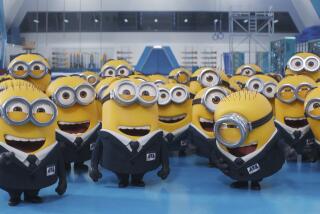Marketing to Children Raises Big Questions
- Share via
Between February and June this year, Mattel Toys gave away thousands of cans of Slime--a neon-green gelatinous goop that’s just one accessory in the endless series of Masters of the Universe figures, vehicles, animals and buildings. Kids love it “cause it’s yicky,” says Ramsey Bitar, 3, of Los Angeles. He puts it in his Slime Pit--at $12, one of the cheaper outbuildings in the Masters category--and then, he says, “I slime all the little people.”
Slime isn’t a new product. Seven years ago, Mattel sold 10 million cans of it as a novelty. It was brought out of retirement this January for the Masters series--a line that started with six-inch He-Man figures in 1982 and is now, according to Mattel, in almost 70% of American homes with boys aged 4 to 10.
Mattel didn’t exactly give away Slime. Until June, Ramsey and all the other kids who used up the can that came with their Slime pits couldn’t buy more. They could only get another can as a “free” gift when they purchased two $6 Masters figures, or, of course, another Slime Pit. “All gone, you go get more Slime,” says Ramsey, “but you have to buy two men and you don’t want them!”
Parents Upset
This innovative little marketing gambit had parents muttering for months. As promotions go, it seems unusual: “They’re positioning it as a bonus, clouding the issue,” says Michael Kamins, assistant professor of marketing at USC. “It’s not really a bonus, and as a strategy, it’s manipulative. You only need a can of Slime, and you have to buy two figures to get it.”
One result was some profiteering: In spite of the “Not for Sale” label, some retailers sold their free cans at prices running from $2.99 to almost $10. “It should be a simple matter to make these refills available at a nominal cost,” grumbled one father. Another was more annoyed that the Slime Pit package said nothing about the availability of refills: “When you buy your Slime Pit,” he says, “you expect to be able to get more Slime.”
The whole discussion surprises Mattel, which only wanted “to build momentum on Masters figures,” says David Capper, until recently Mattel’s group director of product management, and the company didn’t think the two-figure purchase onerous, having originally “talked about making it three or four.” Besides, Capper adds: “It’s such a short-term promotion.”
How Things Should Be Sold
Superficially, the debate seems unimportant--these are, after all, only kids and the product in question only Slime. But it calls up interesting questions--questions asked less often now than in the consumerist 1970s--of how things should be sold, particularly to children, which really means promoted to children and bought by their parents, often under pressure.
The Slime Pit and its Slime are like the age-old razor-and-razor-blades principle: Sell the razor and make the consumer buy blades forever. But with Slime, a twist was added: Suddenly the owner couldn’t get new “blades” without making another $12 purchase.
Such “tie-ins,” too, are a tradition--sometimes premiums (purse-size perfumes with each cologne purchase), sometimes specially purchased goods sold at cost to consumers who made other purchases. Even the toy industry has occasional mail-in specials on items not otherwise available--Kenner Products’ “free figure offers,” for example, such as a free Clark Kent for buying two $4 Super Heroes.
Here, however, the incidental bonus product may be “the one you really want,” says Brooke Warrick, a consultant at SRI (formerly Stanford Research Institute). What’s more, he says, the Slime is not incidental but integral to the Slime Pit: “They usually don’t make you buy something only to get an item you need to complete something else.”
Adults might simply refuse, of course, to go along with the promotion, although, ironically, if Slime were a nationally advertised adult product--with similar restrictions on obtaining necessary refills--they’d probably do more than refuse. Children, however, are different, or so says one side of a debate that has raged since the world of Barbie revolutionized toy selling in 1959--dolls, clothes, props, playsets, all (dread words) “sold separately”--and television revolutionized toy advertising.
Children were made the industry’s salesmen, bombarded directly by what Gerald Lesser, Harvard professor of education and developmental psychology, calls “the visual equivalent of a simple declarative sentence-- ‘Here’s a product, remember it’-- so that if they see it, it’ll be instantly recognizable. Kids don’t have any money: The pressure must be on the parent.”
They have no resistance either, so the pressure is instinctive and considerable. “Children are unique consumers and not just short grown-ups,” says Rita Weisskoff, director of the Children’s Advertising Review Unit of the Council of Better Business Bureaus in New York. “They’re not as prepared to make judicious decisions.”
For a while, parents fought back, organizing against war toys, sexist toys and unsafe toys. In 1968, Action for Children’s Television was formed to fight against unfair hard-sell advertising on children’s TV, and even against the content of the shows, and for a while in the 1970s, the Federal Trade Commission, and therefore the networks, advertising agencies and toy companies were interested.
But consumer agitation isn’t “in” this decade, the FTC is less active and there are problems more important than children’s toys, and certainly more than Slime. There are only occasional complaints about marketing to children, very little public discussion of what’s being sold children and how. And the Slime promotion may be the least of it.
More to Read
Inside the business of entertainment
The Wide Shot brings you news, analysis and insights on everything from streaming wars to production — and what it all means for the future.
You may occasionally receive promotional content from the Los Angeles Times.










